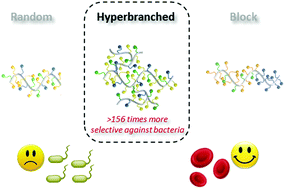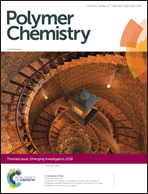The effects of polymer topology and chain length on the antimicrobial activity and hemocompatibility of amphiphilic ternary copolymers†
Abstract
Investigation into the macromolecular structure–activity relationship of synthetic antimicrobial polymers has been gaining scientific interest due to the possibility of discovering new alternatives for combating the increase of multidrug resistance in bacteria. Recently, we reported the development of new antimicrobial polymers in the form of amphiphilic ternary copolymers that consist of low-fouling (oligoethylene glycol), cationic and hydrophobic side chains. The combination of these three main functional groups is crucial in endowing the polymers with high antimicrobial potency against Gram-negative pathogens and low cytotoxicity. Following on from our previous study, we herein present a systematic assessment on the effects of the polymer chain length and architecture (i.e., random vs. block copolymers and linear vs. hyperbranched) on the antimicrobial activity and hemocompatibility of antimicrobial ternary copolymers. The polymer chain length in random copolymers slightly affects the antimicrobial activity where longer chains are marginally more bacteriostatic against Pseudomonas aeruginosa and Escherichia coli. In terms of hemocompatibility, polymers with shorter chains are more prone to hemagglutination. Interestingly, when the hydrophilic and hydrophobic segments are separated into diblock copolymers, the antimicrobial activity is lost, possibly due to the stable core–shell architecture. The hyperbranched structure which consists of 2-ethylhexyl groups as hydrophobic side-chains yields the best overall biological properties, having similar antimicrobial activity (MIC = 64 μg mL−1) and >4-fold increase in HC50 compared to the linear random copolymers (HC50 > 10 000 μg mL−1) with no hemagglutination. The hyperbranched polymers are also bactericidal and kill ≥99% and 90% of planktonic and biofilm Pseudomonas aeruginosa, respectively. This study thus highlights the importance of determining macromolecular structural aspects that govern the biological activity of antimicrobial polymers.

- This article is part of the themed collection: Emerging Investigators


 Please wait while we load your content...
Please wait while we load your content...